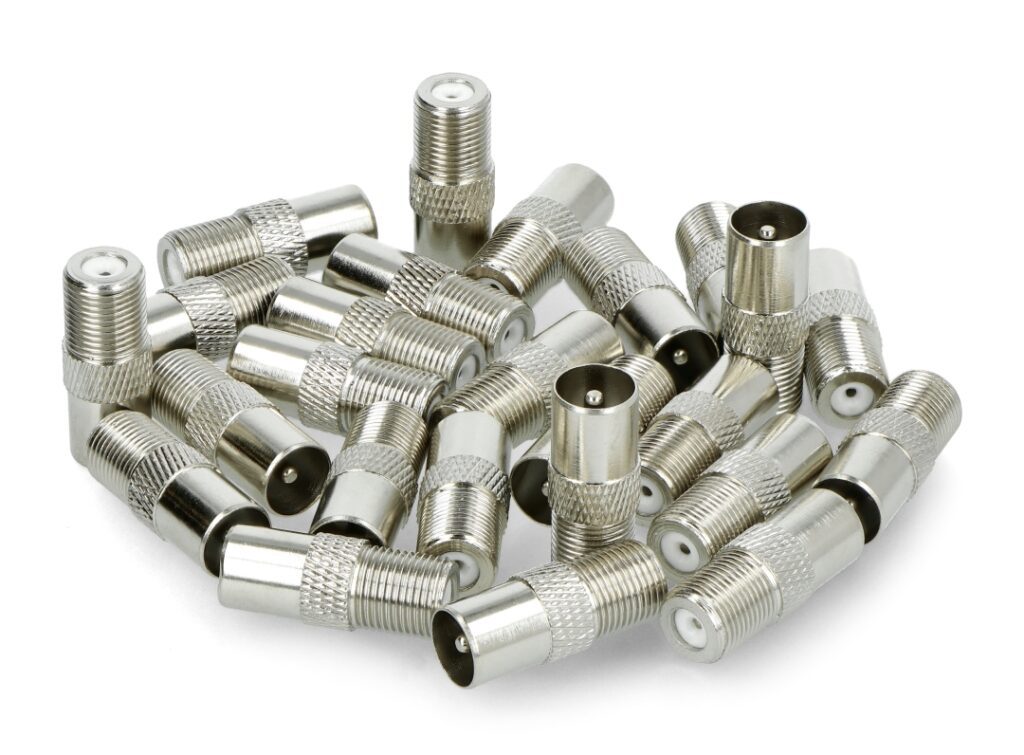Table of Contents:
The F antenna connector is used in satellite and cable TV systems. Used to connecta to a compatible (female) F-type socket.
What is an F antenna connector?
F antenna connectors belong to a group of coaxial connectors used to crimp or twist on the end of a coaxial cable. Their simple and reliable design combined with quick installation make them the most widely used connectors throughout the television industry.
Most F-plugs are distinguished by full weather and rust resistance. The use of a special galvanic coating provides effective protection against UV radiation. In practice, this means that the plug retains its original performance for many years, regardless of the conditions of use. Most connectors are designed for stable operation over a wide operating temperature range of -40 ℃ to as high as +60 ℃.
Selected models of connectors have the so-called double omnidirectional compression that guarantees a durable and stable connection between the connector and the coaxial cable. During the manufacturing process, special attention is paid to the manufacture of the thread, which is responsible not only for assembly, but also for minimal damping.
Construction of the F antenna plug
F antenna connector
has a simple design that guarantees a permanent connection to the coaxial cable and minimal signal loss. The most important part of the plug is the copper wire used to transmit the signal. The cable is protected by insulation that provides separation between the center conductor and the mesh inside. The aforementioned mesh is responsible for shielding. This is another important element that protects the transmitted signal from the effects of external interference, thus ensuring stability.
The outside of the F plug is usually made of metal. There is a thread in the bolt-on models. The threaded design means that installation and removal of the F plug does not require specialized tools.
The connector also has a gasket located near the base of the plug. This item provides additional protection against moisture and other contaminants, including dust.
Types of F-type plugs
The various models of F-plugs differ in design and application, among other things.
The compression plugs are designed to be mounted on the end of the antenna cable using a compression tool. This is a modern solution that speeds up installation. Plugs of this type are mainly used by installers making a large number of connections in a short period of time. Another type is an F plug with a locking mechanism. Connectors of this type are equipped with a special locking device, the main task of which is to prevent accidental disconnection of the plug from the socket. Elements of this type are used in installations where antenna cables are located in areas exposed to jerks, for example.
The next type is an F connector with an angled connector used in places where it is not possible (or very difficult) to use a straight model. Most often these are limited spaces and places in close proximity to a wall, elements, facades or other planes. Other types of plugs include the standard screw connector, also known as a curly connector, and self-tightening F plugs. Each is designed for different applications. The choice of a particular model depends on, among other things. on the type of antenna cable, conditions of use, installation location, requirements for durability and quality of connection, and other variables.
How do I mount the F connector on the cable?
The following information is a general description of the installation of a screw-in F plug on a coaxial cable.
The first step is to cut the outer insulation from the end of the antenna cable. Then you need to expose the wire mesh in such a way that it does not touch the central cable. Unnecessary excess external insulation should be removed. In the next step, you need to put the F connector on the central wire. It is important to remember that the central cable must protrude through the hole located in the connector. Now it was time to screw in the plug. Using the thread, you need to screw the plug in such a way that it is firmly, evenly and securely seated on the cable. The final stage involves an inspection. The wire must not touch the outer mesh.
F-type sockets - construction and key information
The F-type connector is compatible with the F-type socket, the main part of which is mostly made of metal. The body has not only a structural function, but also a shielding function, which effectively protects the signal from the impact of various types of external interference. Another key component of the F-type socket is the dielectric insulator inside the metal body. The main task of this element is to prevent short circuits that could occur due to contact between the central wire and the metal body. The central socket itself is relatively small. Its design is adapted to accept the central wire found in the F plug.
Select models of sockets are also equipped with a gasket, which protects not only from moisture, but also from contaminants, including dust and dirt. Sockets with a seal are mostly installed in installations located outdoors. There are several socket mounts. Among the most popular are clamp, screw and clip mounts. Each F-type antenna jack is designed to provide a durable and reliable connection to a compatible F-plug.
Transitioners, a simple way to change the standard
The variety of plugs and sockets used in TV systems requires different types of adapters. The F to IEC adapter, which allows the connection of a standard F-type plug to an IEC socket, is very popular.
Another frequently used adapter allows an F-type connection to a BNC socket used, among other things. In professional monitoring systems and modern audiovisual equipment. The other models are F on RCA and F on SMA. Other, less popular variants for specific applications are also available on the market.
How useful was this post?
Click on a star to rate it!
Average rating 0 / 5. Vote count: 0
No votes so far! Be the first to rate this post.




















